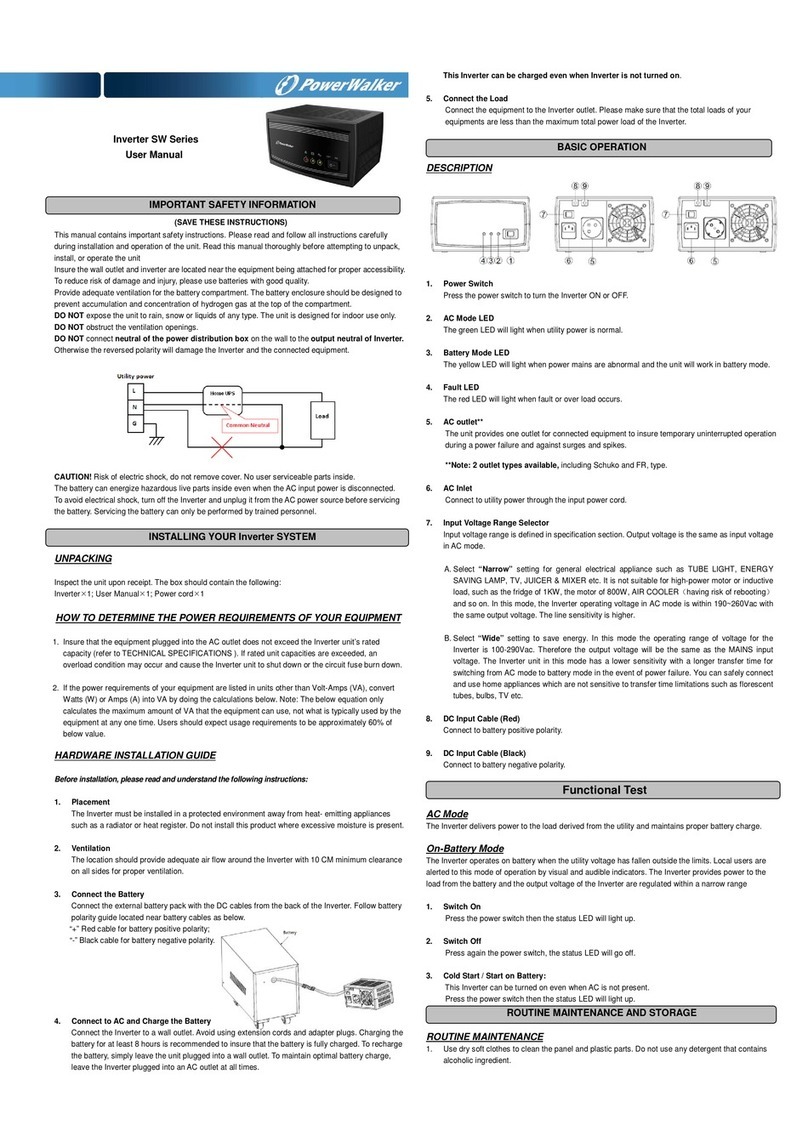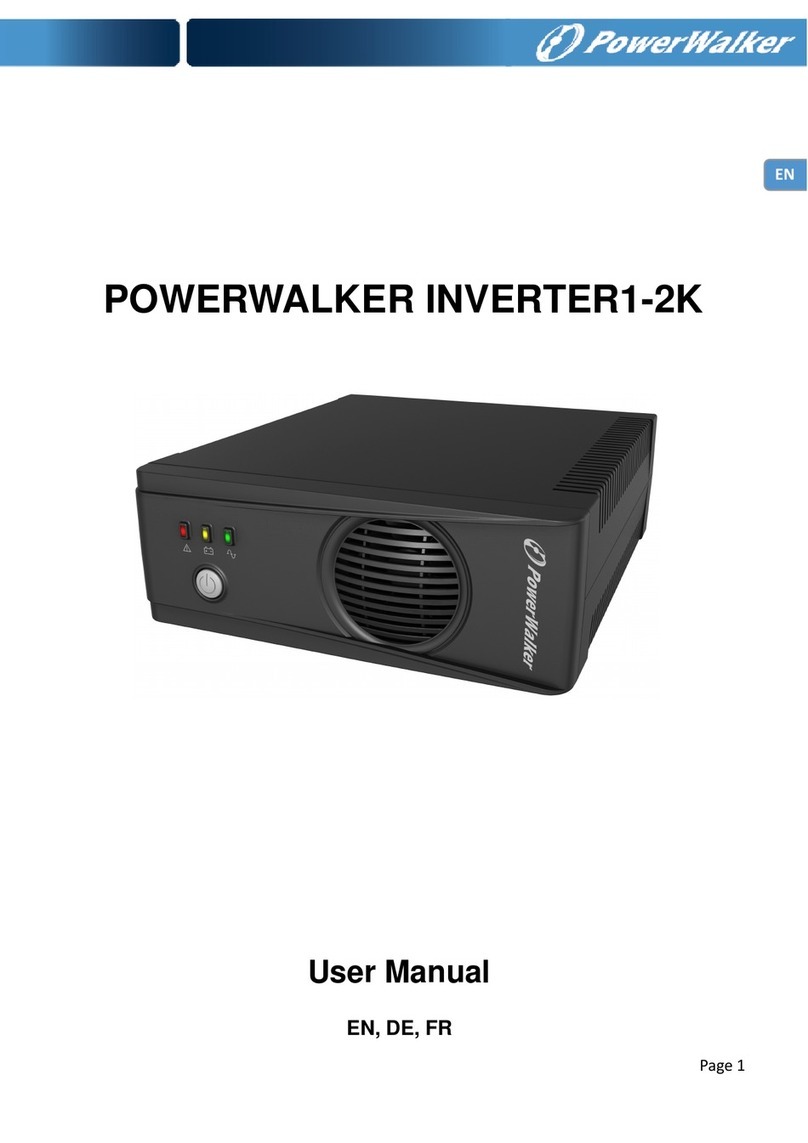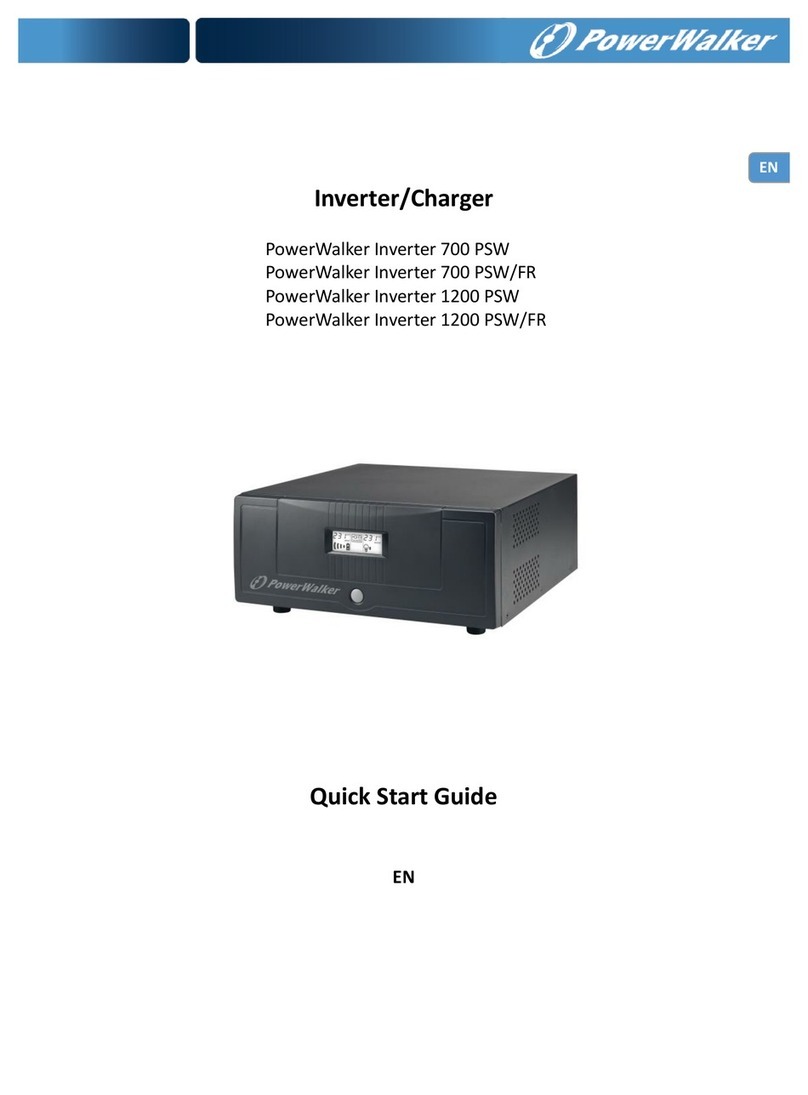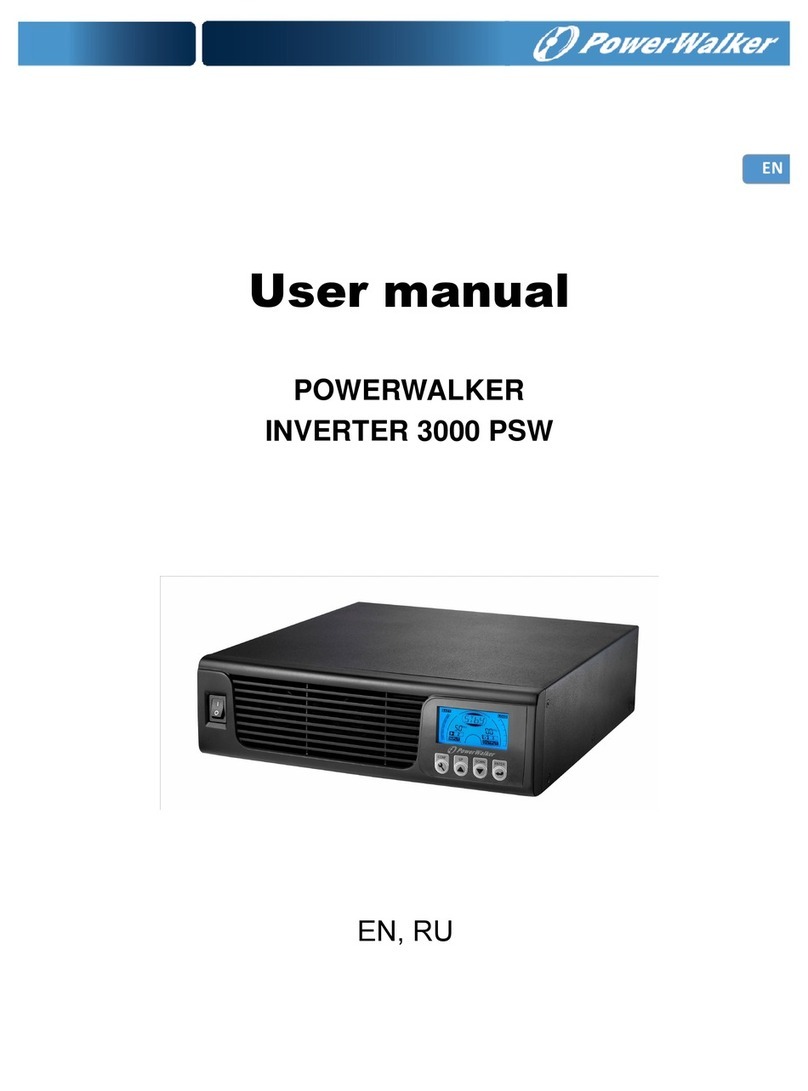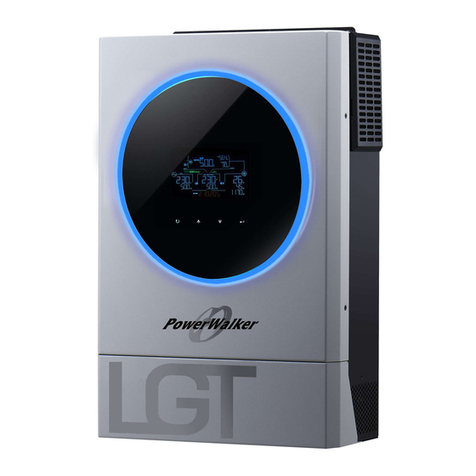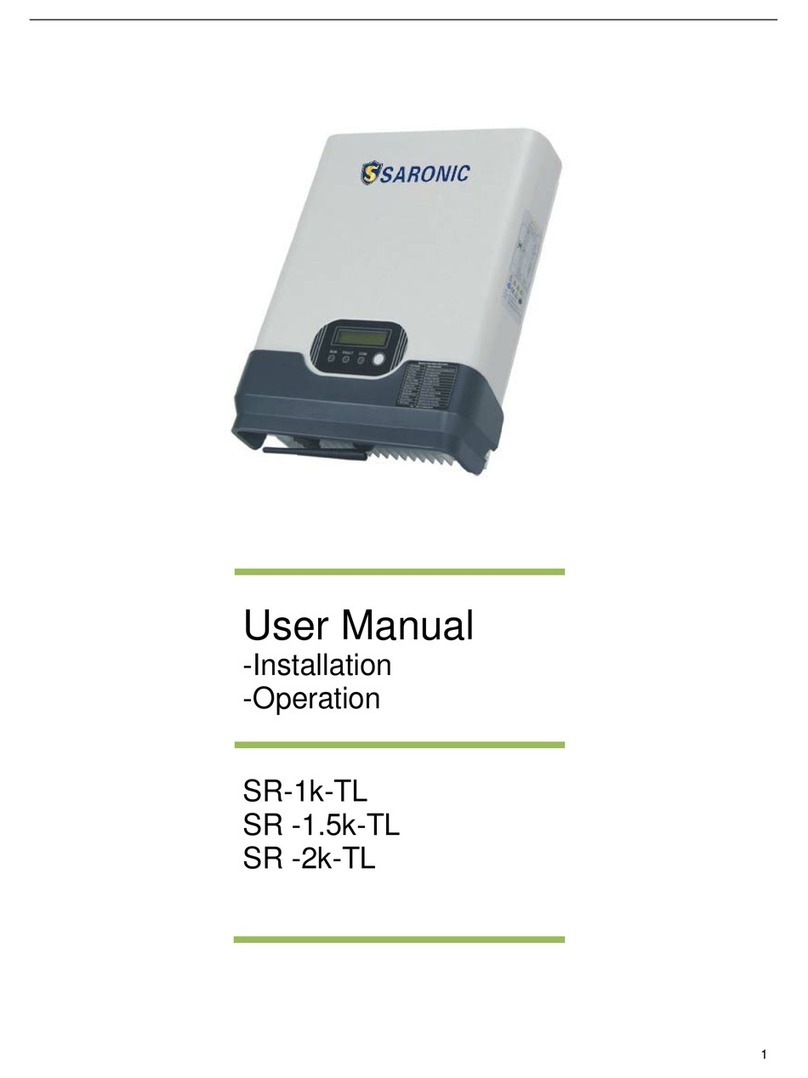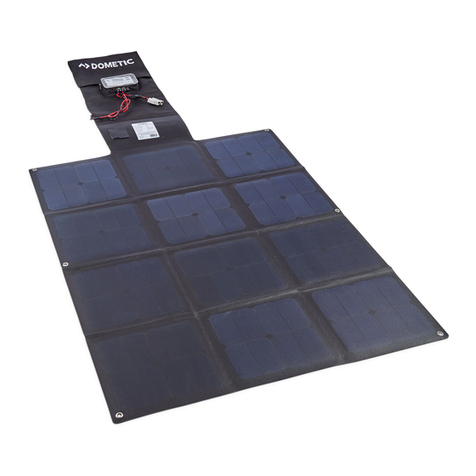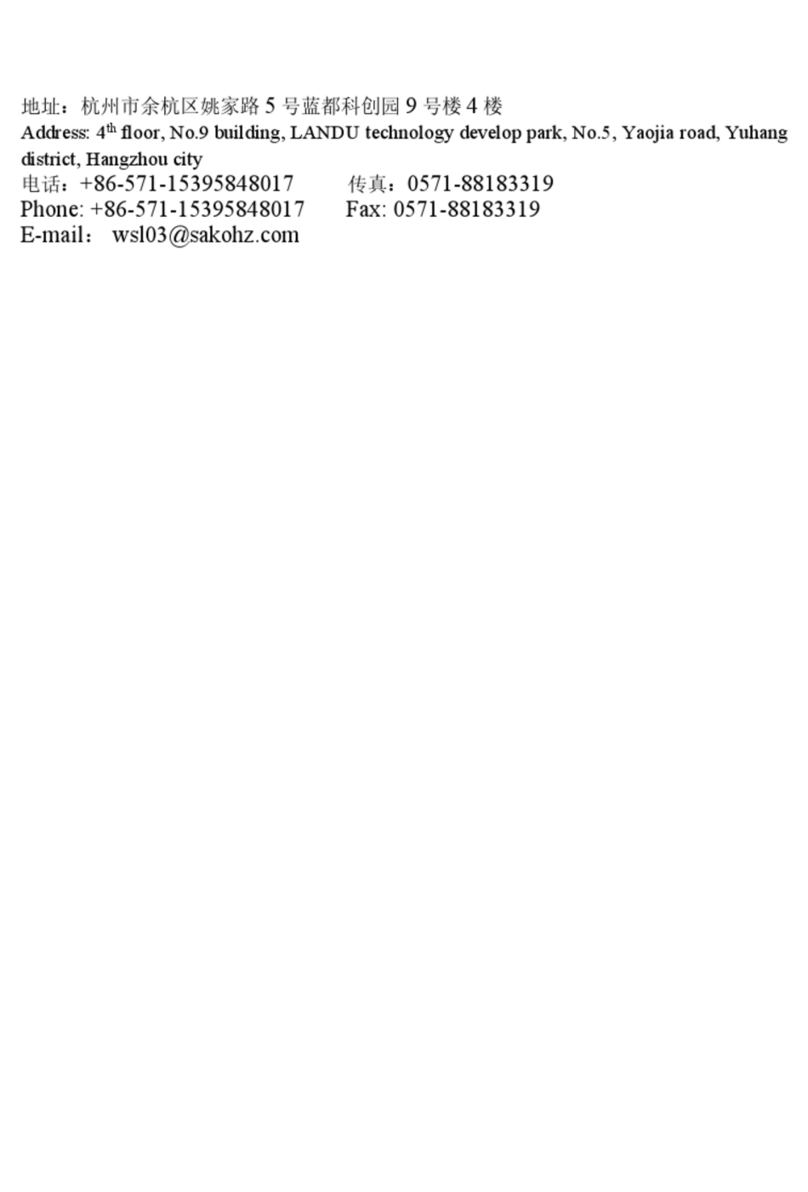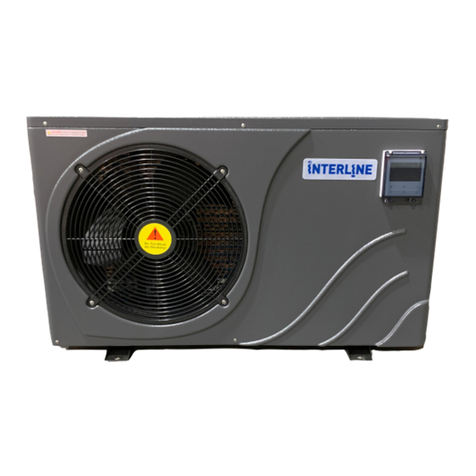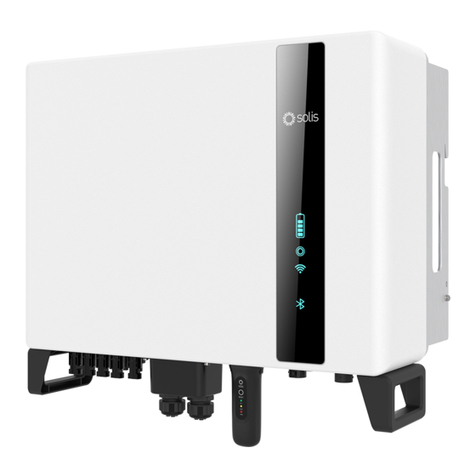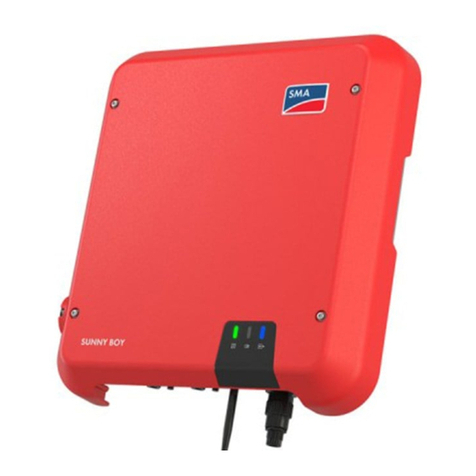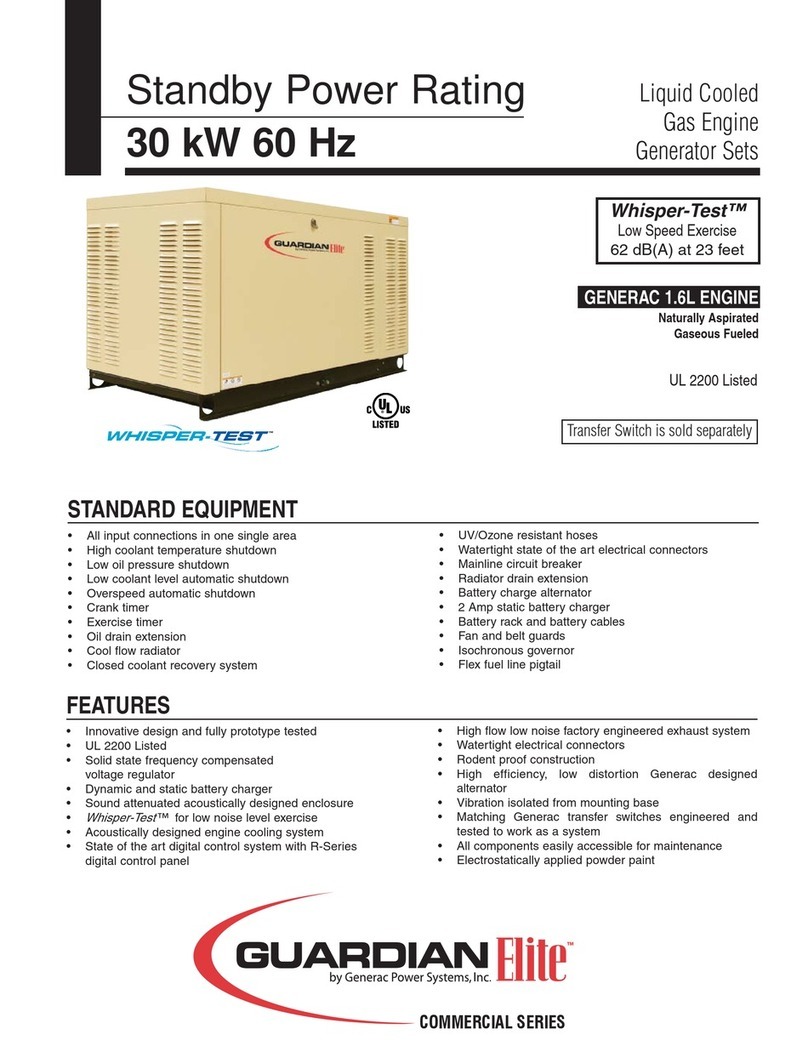PowerWalker SKY 3.6KW User manual

PowerWalker
SOLAR INVERTER SKY
(3600-5600VA)
ON-Grid Charger
Version: 1.1
User Manual

Table Of Contents
ABOUT THIS MANUAL ..................................................................................................................................... 1
Purpose............................................................................................................................................................ 1
Scope ............................................................................................................................................................... 1
SAFETY INSTRUCTIONS.................................................................................................................................. 1
INTRODUCTION ............................................................................................................................................... 2
Product Overview............................................................................................................................................. 3
INSTALLATION ................................................................................................................................................. 4
Unpacking and Inspection ............................................................................................................................... 4
Preparation ...................................................................................................................................................... 4
Mounting the Unit............................................................................................................................................. 4
Battery Connection .......................................................................................................................................... 5
AC Input/Output Connection............................................................................................................................ 6
PV Connection ................................................................................................................................................. 7
Final Assembly................................................................................................................................................. 8
Communication Connection............................................................................................................................. 9
Dry Contact Signal ........................................................................................................................................... 9
OPERATION ..................................................................................................................................................... 10
Power ON/OFF .............................................................................................................................................. 10
Operation and Display Panel ......................................................................................................................... 10
LCD Display Icons ......................................................................................................................................... 11
LCD Setting.................................................................................................................................................... 14
Display Setting ............................................................................................................................................... 26
Operating Mode Description .......................................................................................................................... 30
CLEARANCE AND MAINTENANCE FOR ANTI-DUST KIT.......................................................................... 36
Overview ........................................................................................................................................................ 36
Clearance and Maintenance.......................................................................................................................... 36
SPECIFICATIONS ........................................................................................................................................... 37
TROUBLE SHOOTING..................................................................................................................................... 38
Appendix I: Parallel function ...................................................................... Fehler! Textmarke nicht definiert.
Appendix II: BMS Communication Installation ...................................... Fehler! Textmarke nicht definiert.
Appendix III: The Wi-Fi Operation Guide in Remote Panel ................. Fehler! Textmarke nicht definiert.

1
ABOUT THIS MANUAL
Purpose
This manual describes the assembly, installation, operation and troubleshooting of this unit. Please read
this manual carefully before installations and operations. Keep this manual for future reference.
Scope
This manual provides safety and installation guidelines as well as information on tools and wiring.
SAFETY INSTRUCTIONS
WARNING: This chapter contains important safety and operating instructions. Read and
keep this manual for future reference.
1. Before using the unit, read all instructions and cautionary markings on the unit, the batteries, and all
appropriate sections of this manual.
2. CAUTION --To reduce risk of injury, charge only deep-cycle lead acid type rechargeable batteries.
Other types of batteries may burst, causing personal injury and damage.
3. Do not disassemble the unit. Take it to a qualified service center when service or repair is required.
Incorrect re-assembly may result in a risk of electric shock or fire.
4. To reduce risk of electric shock, disconnect all wirings before attempting any maintenance or cleaning.
Turning off the unit will not reduce this risk.
5. CAUTION – Only qualified personnel can install this device with battery.
6. NEVER charge a frozen battery.
7. For optimum operation of this inverter/charger, please follow required spec to select appropriate cable
size. It’s very important to correctly operate this inverter/charger.
8. Be very cautious when working with metal tools on or around batteries. A potential risk exists to drop
a tool to spark or short circuit batteries or other electrical parts and could cause an explosion.
9. Please strictly follow installation procedure when you want to disconnect AC or DC terminals. Please
refer to INSTALLATION section of this manual for the details.
10. Fuses are provided as over-current protection for the battery supply.
11. GROUNDING INSTRUCTIONS -This inverter/charger should be connected to a permanent grounded
wiring system. Be sure to comply with local requirements and regulation to install this inverter.
12. NEVER cause AC output and DC input short circuited. Do NOT connect to the mains when DC input
short circuits.
13. Warning!! Only qualified service persons are able to service this device. If errors still persist after
following troubleshooting table, please send this inverter/charger back to local dealer or service center
for maintenance.

2
INTRODUCTION
This hybrid PV inverter can provide power to connected loads by utilizing PV power (DC), utility power (AC) and
battery power (DC).
Figure 1 PV System Overview
Depending on different power situations, this hybrid inverter is designed to generate continuous power from PV
solar modules (solar panels), battery, and the utility. When MPP input voltage of PV modules is within
acceptable range (see specification for the details), this inverter is able to generate power to feed the grid
(utility) and charge battery. Never connect the positive and negative terminals of the solar panel to
the ground. See Figure 1 for a simple diagram of a typical solar system with this hybrid inverter.

3
Product Overview
NOTE: For parallel installation and operation, please check
Appendix I.
1. RGB LED ring (refer to LCD Setting section for the details)
2. LCD display
3. Function buttons
4. PV connectors
5. AC input connectors
6. AC output connectors (Load connection)
7. Battery connectors
8. Current sharing port
9. Parallel communication port
10. Circuit breaker
11. Power switch
12. Dry contact
13. USB port as USB communication port and USB function port
14. RS-232 communication port
15. BMS communication port: CAN, RS-485 or RS-232

4
INSTALLATION
Unpacking and Inspection
Before installation, please inspect the unit. Be sure that nothing inside the package is damaged. You should
have received the following items inside of package:
Inverter CD User manual Communication cable
Preparation
Before connecting all wirings, please take off bottom cover by removing two screws as shown below.
Mounting the Unit
Consider the following points before selecting where to install:
Do not mount the inverter on flammable construction
materials.
Mount on a solid surface.
Install this inverter at eye level to allow the LCD display to be
read at all times.
The ambient temperature should be between -10°C and
50°C to ensure optimal operation.
The recommended installation position is to be adhered to
the wall vertically.
Be sure to keep other objects and surfaces as shown in the
right diagram to guarantee sufficient heat dissipation and
to have enough space for removing wires.
SUITABLE FOR MOUNTING ON CONCRETE OR
OTHER NON-COMBUSTIBLE SURFACE ONLY.

5
Install the unit by screwing three screws. It’s recommended to use M4 or M5 screws.
Battery Connection
CAUTION: For safety operation and regulation compliance, it’s requested to install a separate DC over-current
protector or disconnect device between battery and inverter. It may not be requested to have a disconnect
device in some applications, however, it’s still requested to have over-current protection installed. Please refer
to typical amperage in below table as required fuse or breaker size.
WARNING! All wiring must be performed by qualified personnel.
WARNING! It's very important for system safety and efficient operation to use
appropriate cable for battery connection. To reduce risk of injury, please use the
proper recommended cable and terminal size as below.
Recommended battery cable and terminal size:
Model Typical
Amperage
Battery
Capacity
Wire Size
Ring Terminal
Torque
Value
Cable
mm2
Dimensions
D (mm)
L (mm)
3.6KW 100A 200AH
1*4AWG 22 6.4 33.5 2~3 Nm
5.6KW /
6KW
137A 200AH
1*2AWG or 2*6AWG 28 6.4 42.7 2~3 Nm
Please follow below steps to implement battery connection:
1. Assemble battery ring terminal based on recommended battery cable and terminal size.
2. Insert the ring terminal of battery cable flatly into battery connector of inverter and make sure the nuts are
tightened with torque of 2-3 Nm. Make sure polarity at both the battery and the inverter/charge is correctly
connected and ring terminals are tightly screwed to the battery terminals.
Ring terminal:

6
WARNING: Shock Hazard
Installation must be performed with care due to high battery voltage in series.
CAUTION!! Do not place anything between the flat part of the inverter terminal and the ring
terminal. Otherwise, overheating may occur.
CAUTION!! Do not apply antioxidant substance on the terminals before terminals are connected
tightly.
CAUTION!! Before making the final DC connection or closing DC breaker/disconnector, be sure
positive (+) must be connected to positive (+) and negative (-) must be connected to negative (-).
AC Input/Output Connection
CAUTION!! Before connecting to AC input power source, please install a separate AC breaker between
inverter and AC input power source. This will ensure the inverter can be securely disconnected during
maintenance and fully protected from over current of AC input.
CAUTION!! There are two terminal blocks with “IN” and “OUT” markings. Please do NOT mis-connect input
and output connectors.
WARNING! All wiring must be performed by qualified personnel.
WARNING! It's very important for system safety and efficient operation to use appropriate cable for AC input
connection. To reduce risk of injury, please use the proper recommended cable size as below.
Suggested cable requirement for AC wires
Model Gauge Torque Value
3.6KW 12 AWG 1.2~ 1.6 Nm
5.6KW / 6KW
10 AWG
1.2~ 1.6 Nm
Please follow below steps to implement AC input/output connection:
1. Before making AC input/output connection, be sure to open DC protector or disconnector first.
2. Remove insulation sleeve 10mm for six conductors. And shorten phase L and neutral conductor N 3 mm.
3. Insert AC input wires according to polarities indicated on terminal block and tighten the terminal screws. Be
sure to connect PE protective conductor ( ) first.
→Ground (yellow-green)
L→LINE (brown or black)
N→Neutral (blue)
WARNING:
Be sure that AC power source is disconnected before attempting to hardwire it to the unit.
4. Then, insert AC output wires according to polarities indicated on terminal block and tighten terminal screws.
Be sure to connect PE protective conductor ( ) first.

7
→Ground (yellow-green)
L→LINE (brown or black)
N→Neutral (blue)
5. Make sure the wires are securely connected.
PV Connection
CAUTION: Before connecting to PV modules, please install separately a DC circuit breaker between inverter
and PV modules.
WARNING! All wiring must be performed by qualified personnel.
WARNING: Please switch off the inverter before you connect PV modules. Otherwise, it will damage the
inverter.
WARNING! It's very important for system safety and efficient operation to use appropriate cable for PV
module connection. To reduce risk of injury, please use the proper recommended cable size as below.
Model
Typical Amperage
Cable Size
Torque
3.6KW
18A
12AWG
2.0~2.4Nm
5.6KW / 6KW
27A
10AWG
2.0~2.4Nm
PV Module Selection:
When selecting proper PV modules, please be sure to consider below parameters:
1. Open circuit Voltage (Voc) of PV modules do not exceed max. PV array open circuit voltage of inverter.
2. Open circuit Voltage (Voc) of PV modules should be higher than min. battery voltage.
Solar Charging Mode
INVERTER MODEL 3.6KW 5.6KW 6KW
Max. PV Array Open Circuit Voltage
500 Vdc
450 Vdc
500 Vdc
PV Array MPPT Voltage Range 120~430Vdc
MPP Number
1
CAUTION:Appliances such as air conditioner are required at least 2~3 minutes to restart because it’s required
to have enough time to balance refrigerant gas inside of circuits. If a power shortage occurs and recovers in a
short time, it will cause damage to your connected appliances. To prevent this kind of damage, please check
manufacturer of air conditioner if it’s equipped with time-delay function before installation. Otherwise, this
inverter/charger will trig overload fault and cut off output to protect your appliance but sometimes it still causes
internal damage to the air conditioner.
CAUTION: Important
Be sure to connect AC wires with correct polarity. If L and N wires are connected reversely, it may cause utility
short-circuited when these inverters are worked in parallel operation.

8
Please follow below steps to implement PV module connection:
1. Remove insulation sleeve 10 mm for positive and negative conductors.
2. Check correct polarity of connection cable from PV modules and PV input
connectors. Then, connect positive pole (+) of connection cable to positive
pole (+) of PV input connector. Connect negative pole (-) of connection
cable to negative pole (-) of PV input connector.
Recommended PV module Configuration
PV Module Spec.
(reference)
- 250Wp
- Vmp: 30.7Vdc
- Imp: 8.15A
- Voc: 37.4Vdc
- Isc: 8.63A
- Cells: 60
Total solar input power
Solar input
Q'ty of modules
1500W 6 pieces in series 6 pcs
2000W 8 pieces in series 8 pcs
2750W 11 pieces in series 11 pcs
3000W 6 pieces in series
2 strings in parallel
12 pcs
4000W 8 pieces in series
2 strings in parallel
16 pcs
5000W 10 pieces in series
2 strings in parallel
20 pcs
6000W 12 pieces in series
2 strings in parallel
24 pcs
Final Assembly
After connecting all wirings, please put bottom cover back by screwing two screws as shown below.

9
Communication Connection
Serial Connection
Please use supplied communication cable to connect to inverter and PC. Insert bundled CD into a computer and
follow on-screen instruction to install the monitoring software. For the detailed software operation, please
check user manual of software inside of CD.
Wi-Fi Connection
Wi-Fi module can enable wireless communication between off-grid inverters and monitoring platform. Users
have complete and remote monitoring and controlling experience for inverters when combining Wi-Fi module
with SolarPower APP, available for both iOS and Android based device. All data loggers and parameters are
saved in iCloud. For quick installation and operation, please refer to Appendix III - The Wi-Fi Operation Guide
for details.
Dry Contact Signal
There is one dry contact (3A/250VAC) available on the rear panel. It could be used to deliver signal to external
device when battery voltage reaches warning level.
Unit Status Condition Dry contact port:
NC & C
NO & C
Power Off
Unit is off and no output is powered.
Close
Open
Power On
Output is powered from Utility.
Close
Open
Output is
powered
from
Battery or
Solar.
Program 01
set as SUB
Battery voltage < Low DC warning
voltage
Open Close
Battery voltage > Setting value in
Program 21 or battery charging
reaches floating stage
Close Open
Program 01
is
set as
SBU
Battery voltage < Setting value in
Program 20
Open Close
Battery voltage > Setting value in
Program 21 or battery charging
reaches floating stage
Close Open

10
OPERATION
Power ON/OFF
Once the unit has been properly installed and the batteries are connected well, simply press On/Off switch
to turn on the unit.
Operation and Display Panel
The operation and display panel, shown in below chart, is on the front panel of the inverter. It includes one
RGB LED ring, four touchable function keys and a LCD display, indicating the operating status and
input/output power information.
Touchable Function Keys
Function Key
Description
ESC
To exit the setting
USB function selector To enter USB function setting
Up
To last selection
Down
To next selection
Enter To co nfirm/enter the selection in setting mode

11
LCD Display Icons
Icon Function description
Input Source Information
Indicates the AC input voltage and frequency.
Indicates the PV voltage, current and power.
Indicates the battery voltage, charging stage, configured battery
parameters, charging or discharging current.
Configuration Program and Fault Information
Indicates the setting programs.
Indicates the warning and fault codes.
Warning: flashing with warning code.
Fault: lighting with fault code.
Output Information

12
Indicate the output voltage, load in VA, load in Watt and output
frequency.
Battery Information
Indicates battery level in battery mode and charging status in line mode
by 0-24%, 25-49%, 50-74% and 75-100%.
When battery is charging, it will present battery charging status.
Status
Battery voltage
LCD Display
Constant
Current mode /
Constant
Voltage mode
<2V/cell
4 bars will flash in turns.
2 ~ 2.083V/cell
The right bar will be on and the other three bars
will flash in turns.
2.083 ~ 2.167V/cell
The right two bars will be on and the other two
bars will flash in turns.
> 2.167 V/cell The right three bars will be on and the left bar
will flash.
Floating mode. Batteries are fully charged.
4 bars will be on.
In battery mode, it will present battery capacity.
Load Percentage
Battery Voltage
LCD Display
Load >50%
< 1.85V/cell
1.85V/cell ~ 1.933V/cell
1.933V/cell ~ 2.017V/cell
> 2.017V/cell
Load < 50%
< 1.892V/cell
1.892V/cell ~ 1.975V/cell
1.975V/cell ~ 2.058V/cell
> 2.058V/cell
Load Information
Indicates overload.
Indicates the load level by 0-24%, 25-49%, 50-74% and 75-100%.
0%~24% 25%~49%
50%~74%
75%~100%
Charger Source Priority Setting Display
Indicates setting program 10 “Charger source priority” is selected as
“Solar first”.
Indicates setting program 10 “Charger source priority” is selected as
“Solar and Utility”.
Indicates setting program 10 “Charger source priority” is selected as
“Solar only”.

13
Output source priority setting display
Indicates setting program 01 “Output source priority” is selected as
“S UB ”.
Indicates setting program 01 “Output source priority” is selected as
“SB U”.
AC Input Voltage Range Setting Display
Indicates setting program 02 is selected as “ ”. The acceptable AC
input voltage range will be within 90-280VAC.
Indicates setting program 02 is selected as “ ”. The acceptable AC
input voltage range will be within 170-280VAC.
Operation Status Information
Indicates unit connects to the mains.
Indicates unit connects to the PV panel.
Indicates battery type.
Indicates parallel operation is working.
Indicates unit alarm is disabled.
Indicates Wi-Fi transmission is working.
Indicates USB disk is connected.

14
LCD Setting
After pressing and holding ENTER button for 3 seconds, the unit will enter setting mode. Press “UP” or “DOWN”
button to select setting programs. And then, press “ENTER” button to confirm the selection or ESC button to
exit.
Program Description Selectable option
00 Exit setting mode
Escape
01
Output source priority
selection
SUB(default)
Solar energy provides power to the
loads as first priority.
If solar energy is not sufficient to
power all connected loads, Utility
energy will supply power to the loads
at the same time.
SBU
Solar energy provides power to the
loads as first priority.
If solar energy is not sufficient to
power all connected loads, battery
energy will supply power to the loads
at the same time.
Utility provides power to the loads
only when battery voltage drops to
either low-level warning voltage or the
setting point in program 20 or solar
and battery is not sufficient.
02 AC input voltage range
Appliances (default)
If selected, acceptable AC input
voltage range will be within
90-280VAC.
UPS
If selected, acceptable AC input
voltage range will be within
170-280VAC.
03 Output voltage
220Vac
230V (Default)

15
240Vac
04 Output frequency
50Hz (default)
60Hz
05 Solar supply priority
Charge battery first (default)
Solar energy provides power to charge
battery as first priority.
Power the loads first
Solar energy provides power to the
loads as first priority.
06
Overload bypass:
When enabled, the unit
will transfer to line
mode if overload occurs
in battery mode.
Bypass disable
Bypass enable (default)
07 Auto restart when
overload occurs
Restart disable (default)
Restart enable
08 Auto restart when over
temperature occurs
Restart disable (default)
Restart enable
09
Solar energy feed to
grid configuration
Feed to grid disable
(default)
If selected, solar energy is not allowed
to feed to the grid.
Feed to grid enable
If selected, solar energy is allowed to
feed to the grid.

16
10
Charger source priority:
To configure charger
source priority
If this inverter/charger is working in Line, Standby or Fault mode,
charger source can be programmed as below:
Solar first
Solar energy will charge battery as
first priority.
Utility will charge battery only when
solar energy is not available.
Solar and Utility (default)
Solar energy and utility will charge
battery at the same time.
Only Solar
Solar energy will be the only charger
source no matter utility is available or
not.
11
Maximum charging
current:
To configure total
charging current for
solar and utility
chargers.
(Max. charging current
= utility charging
current + solar charging
current)
60A (default)
For 3.6KW models, setting range is
from 10A to 100A.
For 5.6KW / 6KW model, setting
range is from 10A to 120A.
Increment of each click is 10A.
13 Maximum utility
charging current
2A
10A
20A
30A (default)
40A
50A
60A
70A

17
80A
90A
100A
110A (only for 5.6KW/6KW model)
120A (only for 5.6KW/6KW
model)
14 Battery type
AGM (default)
Flooded
User-Defined
If “User-Defined” is selected, battery
charge voltage and low DC cut-off
voltage can be set up in program 17,
18 and 19.
Pylontech battery
If selected, programs of 11, 17, 18
and 19 will be automatically set up.
No need for further setting.
WECO battery
If selected, programs of 11, 17, 18, 19
and 20 will be auto-configured per
battery supplier recommended. No
need for further adjustment.
Programs of 20 and 21 parameters
refer to SOC of battery.
Soltaro battery
If selected, programs of 11, 17, 18
and 19 will be automatically set up.
No need for further setting.
LIb-protocol compatible
battery
Select “LIb” if using Lithium battery
compatible to Lib protocol. If
selected, programs of 02, 26, 27 and
29 will be automatically set up. No
need for further setting.

18
3rd party Lithium battery
If selected, programs of 02, 26, 27
and 29 will be automatically set up.
No need for further setting. Please
contact the battery supplier for
installation procedure.
17 Bulk charging voltage
(C.V voltage)
Default setting: 56.4V
If self-defined is selected in program
14, this program can be set up.
Setting range is from 48.0V to 64.0V.
Increment of each click is 0.1V.
18 Floating charging
voltage
Default setting: 54.0V
If self-defined is selected in program
14, this program can be set up.
Setting range is from 48.0V to 64.0V.
Increment of each click is 0.1V.
19 Low DC cut off battery
voltage setting
Default setting: 40.8V
If self-defined is selected in program
14, this program can be set up.
Setting range is from 40.8V to 48.0V.
Increment of each click is 0.1V. Low
DC cut-off voltage will be fixed to
setting value no matter what
percentage of load is connected.
20
Battery stop discharging
voltage when grid is
available
default setting: 46V
Setting range is from 44V to 51V and
increment of each click is 1V.
10% (default)
If “WECO battery” is selected in
program 14, the parameter will be
fixed at 10% SOC of battery.
21
Battery stop charging
voltage when grid is
available
Battery fully charged
The setting range is from 48V to 58V
and increment of each click is 1V.
Default setting: 54V
15% (default)
If “WECO battery” is selected in
program 14, this parameter will refer
to the SOC of battery and adjustable
from 15 to 100%. Increment of each
click is 5%.
This manual suits for next models
2
Table of contents
Other PowerWalker Inverter manuals
Popular Inverter manuals by other brands
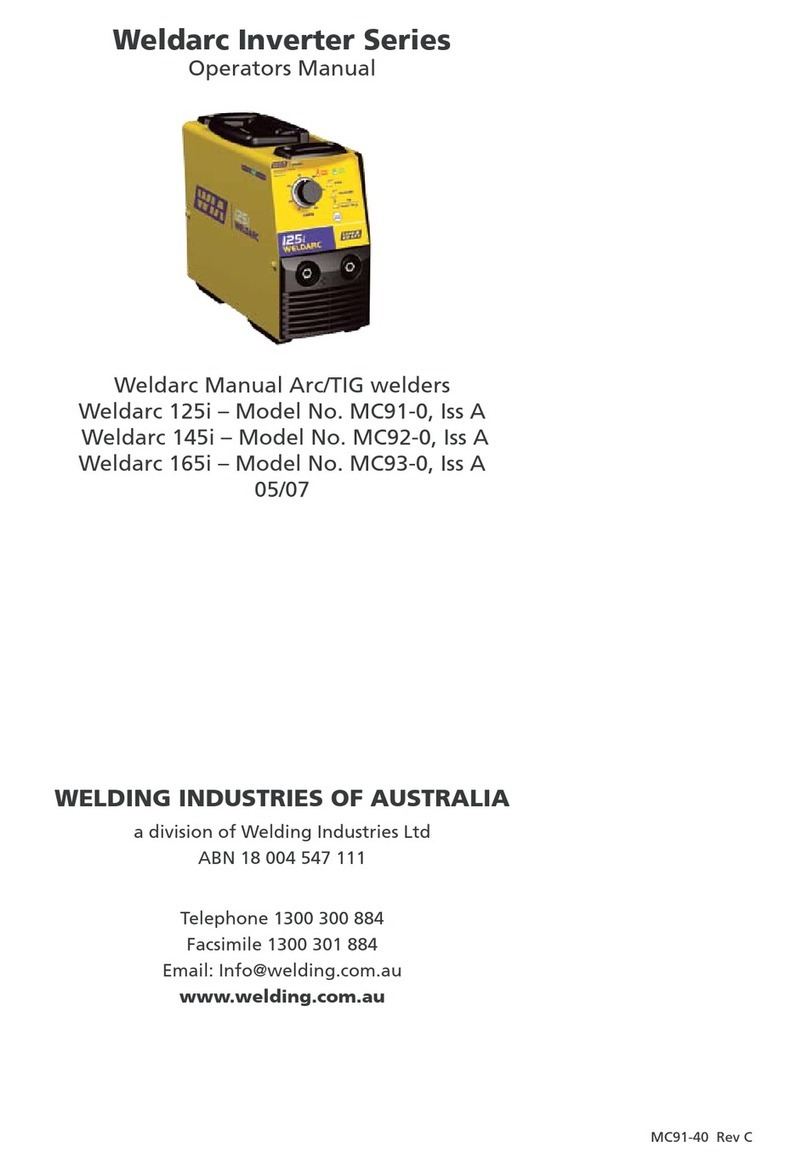
WELDING INDUSTRIES
WELDING INDUSTRIES 125i MC91-0 Operator's manual

Voltacon
Voltacon LV 6KVA-48V user manual
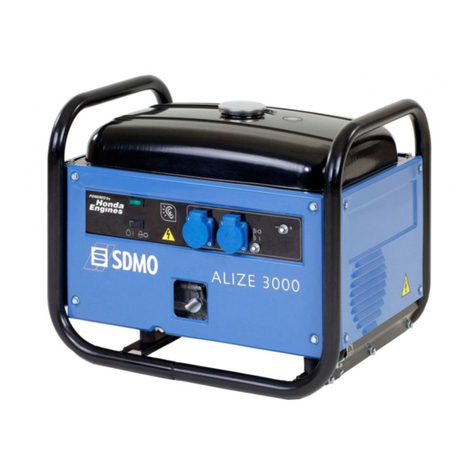
SDMO
SDMO ALIZE 3000 User and maintenance manual
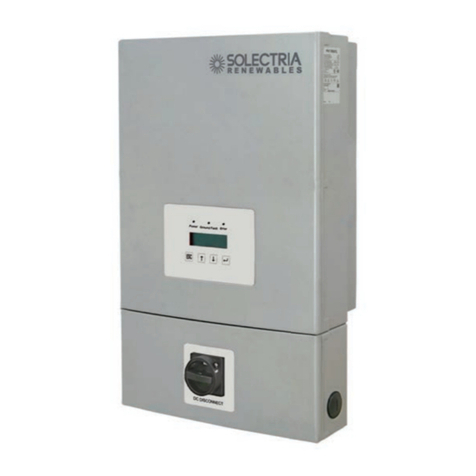
Solectria Renewables
Solectria Renewables PVI 3800TL Installation and operation manual

Daikin
Daikin F-Series Service manual
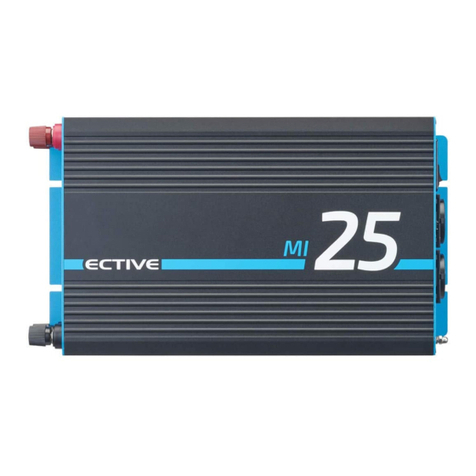
ECTIVE
ECTIVE MI Series Installation and operating instructions
